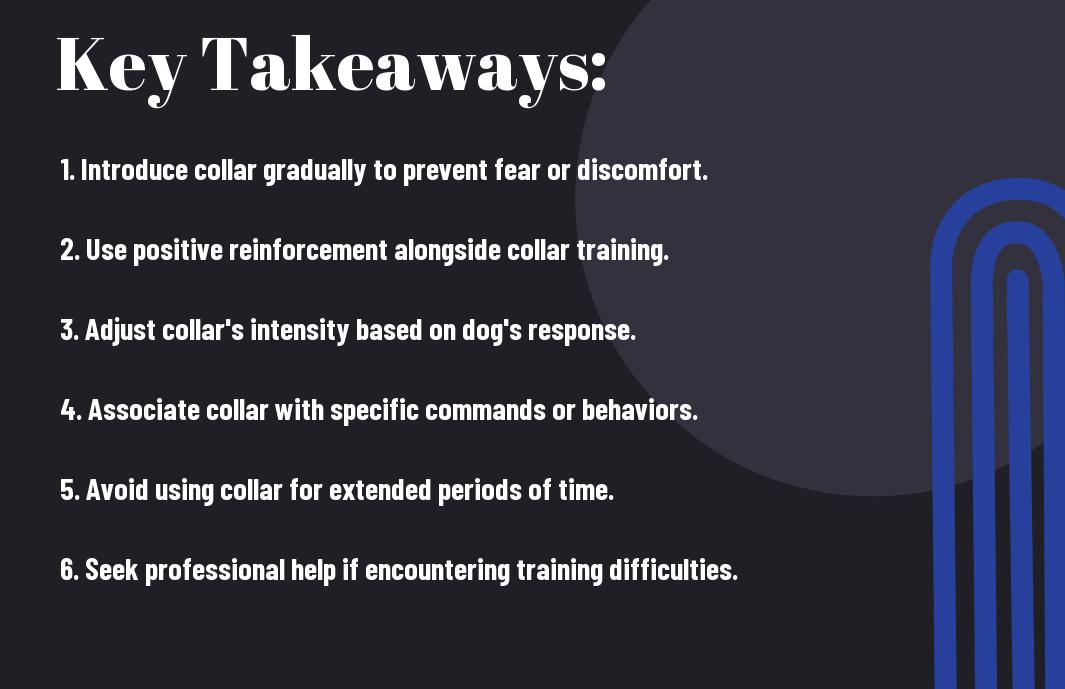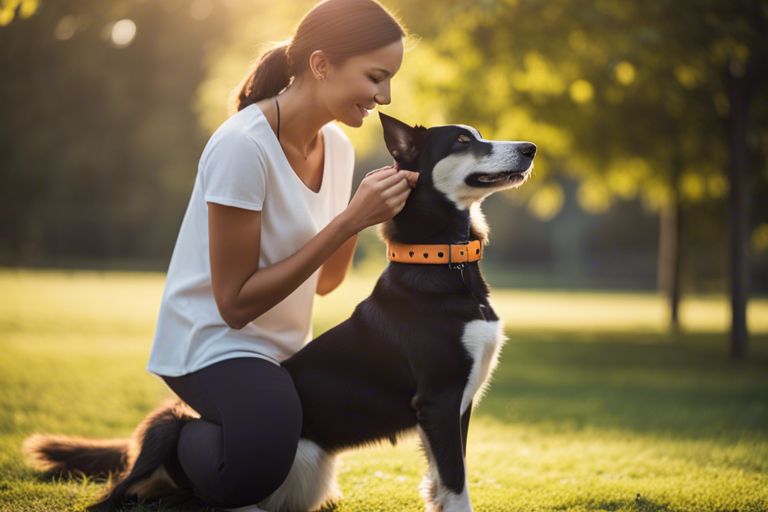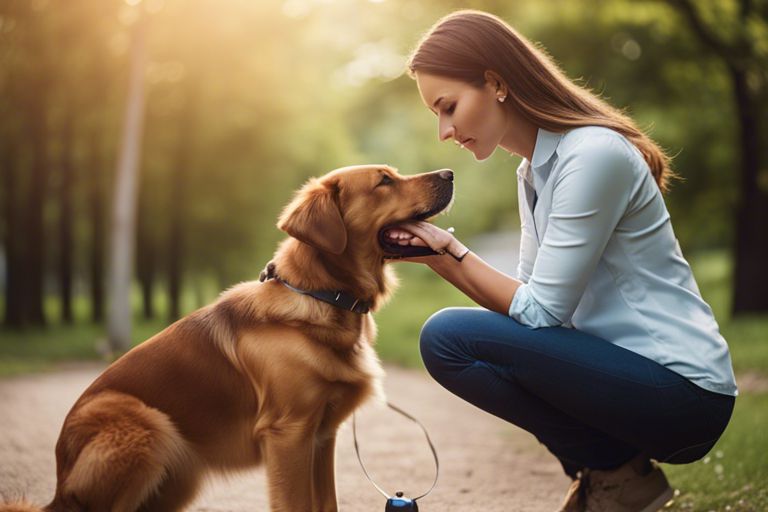Indubitably, the use of a vibration collar can be an effective tool in training dogs. These collars deliver a gentle vibration to the dog’s neck as a form of correction or reinforcement during training sessions. It is important to note that the use of vibration collars should be implemented with caution and responsibility to ensure the safety and well-being of the canine companion.
When utilizing a vibration collar to train a dog, it is crucial to first properly introduce the device to the animal and ensure a proper fit. The collar should be used in conjunction with positive reinforcement techniques to encourage desired behaviors and discourage unwanted ones. It is essential to only use the collar under the guidance of a professional trainer and to never leave it on the dog for extended periods of time. Additionally, always monitor the dog’s reaction to the collar and discontinue use if any signs of distress or discomfort are present.
Key Takeaways:
- Choose the right collar: Ensure you select a vibration collar that is appropriate for your dog’s size and temperament. A collar that is too heavy or intense can be harmful to your pet.
- Introduce the collar gradually: Start by allowing your dog to become accustomed to wearing the collar without activating the vibration. This will help prevent fear or anxiety associated with the collar.
- Use positive reinforcement: Pair the vibration with a command and reward your dog when they respond appropriately. This will associate the vibration with positive behavior and encourage compliance.
- Be consistent and patient: Like any training method, using a vibration collar requires consistent application and patience. It may take time for your dog to understand and obey the commands associated with the collar.
- Monitor your dog’s reaction: Pay attention to your dog’s behavior and body language when using the vibration collar. If they show signs of distress or discomfort, discontinue use and seek alternative training methods.

Basics of Vibration Collars
One of the most effective tools for training dogs is the vibration collar. It is a device that emits a gentle vibration to get the attention of the dog without causing any harm.
Understanding the Technology
The vibration collar works by using a small motor to create a vibration that is felt by the dog when the collar is activated. This vibration is similar to the sensation of a cell phone on vibrate mode, and it is a subtle but effective way to get the dog‘s attention.
Choosing the Right Vibration Collar for Your Dog
An important consideration when choosing a vibration collar for your dog is the size and weight of the dog. It is crucial to select a vibration collar that is appropriate for your dog to ensure comfort and proper functionality. Additionally, look for collars with adjustable vibration levels to accommodate the dog‘s sensitivity.
To ensure you select the best vibration collar for your dog, consider factors such as the dog‘s size, sensitivity, and the specific training needs. It’s essential to choose a collar that is comfortable and safe for your dog, as well as effective in delivering the necessary training stimulation.
Preparing for Training with a Vibration Collar
Unlike other training methods, using a vibration collar to train dog requires careful preparation to ensure success. Before you begin using a vibration collar to train your dogs, there are several key factors to consider.
Assessing Your Dog’s Temperament and Behavior
On first, it’s important to assess your dogs‘ temperament and behavior to determine if they are suitable candidates for vibration collar training. Some dogs may be sensitive to the vibrations, while others may be more resilient. Additionally, consider your dogs‘ behavior and willingness to respond to commands in a training environment. Taking the time to understand your dogs‘ individual temperaments will help set realistic expectations for the training process.
Establishing a Baseline for Communication
Behavioral consistency is with establishing a baseline for communication with your dogs. Before introducing the vibration collar, ensure that your dogs consistently respond to verbal commands. This will establish a foundation for them to understand that the vibrations from the collar are associated with specific behaviors or commands.
It’s essential to introduce the vibration collar as a supplementary form of communication, rather than a primary method of control. By reinforcing existing verbal commands, you can create a clear association between the collar’s vibrations and desired behaviors.
Safety Considerations and Precautions
One of the most important aspects of using a vibration collar for dog training is to prioritize safety. It’s crucial to use a collar specifically designed for training purposes, ensuring that it is not too tight or too loose around your dogs‘ necks. Additionally, regularly check the collar for any signs of discomfort or irritation to prevent any adverse reactions.
Communication with your dogs and consistent, positive reinforcement are vital during the training process. Be mindful of any signs of distress or anxiety in your dogs, and always prioritize their well-being over the training objectives.

The Training Process
Your dog’s training process with vibration collars will involve several key steps to ensure the best results. By following these guidelines, you can effectively use the vibration collar to train your dogs in a positive and safe manner.
Basic Commands and Vibration Collar Use
Basic commands such as “sit,” “stay,” and “come” are essential for using a vibration collar effectively. Begin by familiarizing your dogs with these commands using traditional training methods. Once your dogs understand and consistently respond to the commands, you can begin incorporating the vibration collar into the training process at the lowest stimulation level.
Gradually Increasing Stimulation Levels
Basic commands should be reinforced using the vibration collar at a low level of stimulation initially. As your dogs become more accustomed to the collar, gradually increase the level of stimulation. Be sure to observe your dogs carefully for any signs of distress or discomfort, and adjust the level accordingly.
Commands such as “sit” and “stay” can be reinforced using the vibration collar to provide consistent feedback to your dogs during training sessions. It’s important to use the collar in conjunction with positive reinforcement techniques to create a balanced training approach.
Incorporating Positive Reinforcement Techniques
To complement the use of the vibration collar, incorporate positive reinforcement techniques such as treats, praise, and playtime. This will help create a positive association for your dogs with the training process and the vibration collar.
For instance, when your dogs successfully respond to a command while wearing the vibration collar, immediately reward them with a treat and verbal praise. This will reinforce the desired behavior and motivate your dogs to continue responding positively to the collar’s stimulation.
Advanced Training Techniques
Not all dogs respond the same way to basic training techniques, so it’s important to have an arsenal of advanced training techniques at your disposal. Below, we’ve outlined some advanced training techniques that can help you take your dog’s training to the next level:
- Targeting: Teach your dogs to touch a specific target with their nose or paw, which can be useful for teaching advanced commands or tricks.
- Shaping: Gradually shaping your dog’s behavior by reinforcing small steps towards the desired behavior, which can be useful for teaching complex behaviors.
Troubleshooting Common Training Challenges
On occasion, some dogs may struggle with certain training techniques or exhibit resistance. This can be frustrating for both the dog and the handler. If you encounter this, be patient and consider alternative methods to achieve the desired result.
On the flip side, some dogs may exhibit over-excitement or hyperactivity during training. In these cases, it’s important to remain calm and use techniques such as establishing a “time out” area to help the dog calm down.
Solidifying Learned Behaviors
Techniques to solidify learned behaviors include continuing to reinforce the behavior in a variety of environments and with distractions present. Consistency and positive reinforcement are key to ensuring that the behavior becomes ingrained in the dog’s routine.
To further solidify learned behaviors, it can be helpful to introduce new, more challenging tasks to keep the dog engaged and motivated. This will help reinforce the training and prevent regression.
Transitioning Away from the Collar
Any reliable training tool should ultimately become unnecessary for maintaining your dog’s skills. Once your dog has mastered a behavior with the vibration collar, gradually reduce the dependence on the collar while maintaining consistent training and reinforcement.
Advanced techniques, such as incorporating more complex distractions and challenges during training, can help solidify the learned behaviors and further eliminate the need for the collar.
Ongoing Maintenance and Care
After learning how to use vibration collars to train dogs, it’s important to understand the ongoing maintenance and care required to keep the collars in optimal condition.
Vibration Collar Maintenance and Battery Management
The proper maintenance of vibration collars is crucial for their effectiveness in training dogs. It’s important to regularly check the collar for any signs of wear and tear, and to clean it as needed. Additionally, keeping the battery charged is essential for ensuring consistent and reliable performance. Regularly inspecting and replacing the battery as needed will prevent any interruptions in training sessions.
Periodic Reassessment of Training and Collar Fit
On a regular basis, it’s important to reassess the training methods being used with the vibration collar and the fit of the collar on the dog. Training needs may change over time, so it’s crucial to adjust the intensity and frequency of the vibrations as necessary. Furthermore, ensuring the collar fits the dog properly will prevent any discomfort or irritation that could hinder the effectiveness of the training.
To ensure the ongoing effectiveness of the vibration collar, it’s important to regularly assess and adjust the training methods and collar fit as needed. This will help maintain the positive results achieved through the use of the collar and ensure the safety and well-being of the dogs being trained.

Ethical Considerations and Best Practices
For many dog owners, the use of vibration collars for training can raise ethical questions. It’s important to consider the well-being of your pets and the best practices for using this tool effectively.
Understanding the Debate Around Vibration Collars
One of the most debated topics in dog training is the use of vibration collars. Some argue that they can be an effective tool for teaching commands and correcting behaviors, while others believe they can be harmful and cause distress to the animal. It’s important to consider both sides of the debate and make an informed decision based on the well-being of your dogs.
One of the key considerations in the debate is the potential for misuse of vibration collars. Like any training tool, proper education and understanding are essential to ensure that these collars are used responsibly and effectively. It’s important to be aware of the potential risks and benefits before incorporating vibration collars into your training routine.
Ensuring Humane Training Methods
Vibration collars can be a valuable tool for training dogs, but it’s crucial to ensure that humane methods are used. Proper training techniques and positive reinforcement should always be the foundation of any training program. Vibration collars should be used as a supplement to these methods, rather than a replacement for them.
Methods such as positive reinforcement, consistency, and patience are essential for effective and ethical training with vibration collars. It’s important to prioritize the well-being and comfort of your dogs throughout the training process.
Conclusion
Presently, using a vibration collar to train a dog can be an effective and humane method to modify their behavior. By understanding the proper use of the collar, pet owners can address issues such as excessive barking or boundary training in a way that is safe for their dog. It is important to always pair the collar with positive reinforcement and to never use it as a form of punishment. With consistent and patient training, a vibration collar can help to improve communication and obedience between a dog and their owner.
In conclusion, when using a vibration collar to train a dog, it is crucial to educate yourself on its proper usage and to seek guidance from professional trainers if needed. It is important to use the collar responsibly and with the dog’s well-being in mind. With the right approach, a vibration collar can be a valuable tool in training and improving the behavior of your canine companion.
FAQ: Using a Vibration Collar to Train Your Dog
Q: How does a vibration collar work for dog training?
A: A vibration collar delivers a gentle, humane vibration as a training cue to your dog. This vibration serves as a form of communication with your pet, helping to reinforce commands and discourage unwanted behaviors.
Q: What are the benefits of using a vibration collar?
A: Vibration collars are an effective and safe tool for training your dog. They provide a non-invasive way to communicate with your pet and can help reinforce positive behaviors, correct unwanted behaviors, and improve obedience. They are also a helpful tool for training dogs with hearing impairments.
Q: How do I use a vibration collar to train my dog?
A: To use a vibration collar effectively, it’s important to first acclimate your dog to the collar. Start by introducing the collar to your pet in a positive and gentle manner. Once your dog is comfortable with the collar, use it to reinforce commands and redirect unwanted behaviors. It’s important to provide clear and consistent training cues to your pet while using the collar.
Q: Are vibration collars safe for my dog?
A: When used properly, vibration collars are safe for your dog. It’s important to follow the manufacturer’s guidelines and not use the collar as a punishment tool. Always start with the lowest vibration level and observe your dog’s response. Additionally, do not leave the collar on for extended periods of time, and regularly check for any signs of irritation on your dog’s skin.
Q: Are there any situations where a vibration collar should not be used?
A: Vibration collars may not be suitable for all dogs, particularly those with anxiety or fear-based behaviors. Additionally, it’s important to consider any underlying medical conditions your dog may have before using a vibration collar. Consult with a professional dog trainer or veterinarian if you have concerns about using a vibration collar for your specific dog.
